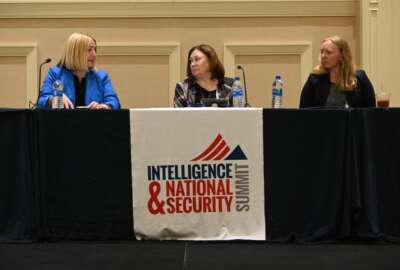For DoD financial management systems, a not-so-pretty picture
One reason the Defense Department can't get to a clean financial audit has to do with its multiple and outdated financial management systems. The DoD does have ...
One reason the Defense Department can’t get to a clean financial audit has to do with its multiple and outdated financial management systems. The DoD does have a plan to modernize the systems, but the Office of Inspector General (OIG) finds a little trouble with how officials are going about it. For the latest, the Federal Drive with Tom Temin talked with OIG project manager Chris Hilton and Shelby Barnes.
Interview Transcript:
Tom Temin And fair to say, this was an audit, not so much of DoD finances, but of the systems that make up the financial network there and of their plans to modernize it. That a good way to put it?
Shelby Barnes Yes. So I think that’s a great way to summarize what this audit was. We focused on the DoD financial systems specifically. We reviewed the systems that were subject to the Federal Financial Management Improvement Act. Essentially, this is a law that requires that systems capture data and record transactions properly. And the DoD has established goals to, as you said, modernize its systems environment and to update its systems or stop using some of its old systems by 2028. However, what we found in our audit was that goal wasn’t aggressive enough. And without a more modern systems environment, we found that the DoD will just continue to spend a lot of money on systems that don’t record those transactions properly.
Tom Temin And just to define the scope of this, it’s not just the Pentagon and the fourth estate agencies, but does this also include the armed forces and they’re often multiple financial systems?
Chris Hilton Yes. It definitely includes all of those systems and all those parts and pieces of the DoD. We looked at basically any plans related to maintaining the DoD’s IT system environment and how they impact the DoD financial statements. By the numbers DoD’s IT environment contains over 400 systems and applications and over 2000 interfaces. This complex environment contributes to many of the DoD challenges.
Tom Temin Right. And it’s not simply the multiplicity of them, but in some cases, the age of them and the fact that they can’t interoperate with one another in some cases. Fair to say?
Chris Hilton That is absolutely correct. I think some of the systems that the DoD still uses today are from the 1950s and 1960s and 1970s. Obviously, they weren’t necessarily always intended to produce financial statements. That’s a newer requirement. So those are some of the challenges that the department is dealing with.
Tom Temin Right. Because in the 1950s and 1960s, they could count the beans, so to speak, but they don’t meet what are considered contemporary standards for financial systems.
Chris Hilton Correct.
Shelby Barnes Yes. That’s correct.
Tom Temin Plus, there’s a certain cost in maintaining these old systems, and the multiplicity is a cost multiplier itself. Fair to say.
Chris Hilton That is fair to say. One of our highlights in our report is that the DoD maintains 37 purchasing systems throughout all its components and pieces. And obviously, that presents challenges from the perspective of, well, if you have a challenge across 37 systems, and you have to have 37 corrective actions, so that does present significant challenges for the department.
Tom Temin Right. And you mentioned they have 400 systems with 200 interfaces. So that’s even beyond the purchasing systems.
Chris Hilton 2,000 interfaces. I wish it was 200.
Tom Temin Yeah, I didn’t write the third one down on my sheet here. Ok, so we’ve got the full scope of that. And let’s talk about the scope of the plan. That is to say, what do they hope to do by 2028 at this point. What’s their envision for all of this.
Shelby Barnes Yeah. So that’s actually one of the things that we identified within our audit that wasn’t particularly clear. The DoD has multiple plans, all of which focus on a simplified systems environment. That is the department’s desire and that is the DoD’s goal. But what we found was that the plans didn’t clarify what systems the DoD plans to keep and what systems they plan to retire between now and 2028. And so that was one of the things that we highlighted within our report, that the DoD does need to clarify what systems it plans to update, to modernize, and which of those systems it needs to stop using. And we recommended that they stop using them as swiftly as possible.
Tom Temin Right. It sounds therefore like the plan is more of a guidance to a future vision than a detailed modernization plan.
Shelby Barnes Yes, I would say that’s exactly what we found within our audit.
Tom Temin We’re speaking with Shelby Barnes and Chris Hilton. They are project managers in the Office of Inspector General at the Defense Department. And did you find that they’re putting sufficient resources against this modernization effort? And is it in the right place? That is it a CIO project? Is it a CFO project or is it across different boundaries?
Chris Hilton I would say there are definitely putting a lot of resources in the area. I think our audit found that there was approximately $4 billion they spent in 2022 on these financial management system. And I think that’s one of the challenges we identified, obviously, from the perspective of you’re spending so much on these systems that aren’t going to get you where you want to go in the current year. And if you just kind of do things as swiftly as possible, like Shelby mentioned, they will get the department to a lot better place.
Tom Temin I mean, is there a strategy to say take within one of the armed services, for example, or in something like [Defense Information Systems Agency (DISA)], which is a large component agency, and just consolidate within that piece that component, which would maybe eliminate dozens. And then try to get the Air Force and the Army and DISA together. I’m just making that up, but that idea.
Shelby Barnes There definitely are goals that each of, you mentioned, like the Army, Navy and Air Force, they all have their own goals, the plans that we were looking at work for the entire DoD. So I think that what you’re speaking about definitely exists at that individual component level. Our review just determined at the entire DoD level. Was the plan detailed enough to get the department where it wants to go?
Chris Hilton I would also add to that that there’s significant initiatives there to move the department in the right direction, and there are indications that they’re doing so. I know, for example, U.S. Marine Corps, they transition to a modern ERP in an effort to attain a clean on their opinion. So there is definitely traction there. I think one of the biggest things talking about, like it being a CIO challenge or a CFO challenge or a military department challenge, is really a team effort. And this is one thing that Mr. Stephens, the deputy chief financial officer, has really focused on. This is a team effort being DoD. DoD is not going to get across the finish line without everyone pushing in the same direction. So that’s one thing that has been a laser focus of the department. It’s really like this is a team effort, both horizontally across CIO and CFO, but also vertically down to the components and up to DoD.
Tom Temin And what were your major recommendations then?
Shelby Barnes So one of the most significant recommendations that we made was for the department to create a strategy where it basically determines for all of its systems, whether or not they’re going to update their system or if they are going to retire and stop using that system. Essentially, the DoD needs to we believe that the strategy is important because the DoD really needs to wrap their arms around what they have now, and they need to determine what’s going to remain and get those systems updated so that they can start producing good and reliable data.
Tom Temin And these financial systems, are these a subset of the business systems that comprise the DoD? Because they’ve had several runs at business system modernizations over the years, at least the 20 years I’ve been looking at it closely. There have been several gambits to try to get around the business systems, financial systems, a subset here?
Chris Hilton Yeah, there are actually, approximately 4600 DoD IT systems, and only about 5% of them currently fall in the category of financial management systems. So it’s a actually a quite small subset of the bigger DoD system environment. And obviously trying to get our arms or DoD trying to get its arms around that environment is needed, obviously, to produce good financial data and hopefully obtain an audit opinion.
Tom Temin And in general on the plan they have, which doesn’t have the detail that you feel they do need, but their plan to 2028, is this basically an in-house effort or do they have integrator support and programmer contractor support?
Chris Hilton It’s kind of a mixed bag. I mean, obviously there’s a lot of contractor support in this effort. So it is diverse I guess, in how they’re addressing the issue.
Tom Temin All right. And would you say that this is an urgent set of recommendations, this audit. And this publication.
Shelby Barnes I would say yes. We feel that this audit report and this recommendation is really imperative. We know that the DoD is working very hard and putting a lot of resources towards modernizing its systems. But we feel that some of the recommendations within this report are really going to put the department on the right track to modernize their system environment, maybe quicker, and that has a direct impact on so many things operationally. And then also the financial statement office.
Tom Temin And your memorandum went to the secretary, the deputy secretary, the undersecretary, the Comptroller, the CIO, the auditors, and so on of the different armed services. They know they’ve got a problem, fair to say.
Chris Hilton That’s fair to say.
Tom Temin And did they generally concur with your recommendations?
Chris Hilton Yes. Actually, we had 31 recommendations, quite a few. They concurred with all but one, and the one that they didn’t concur with we did ask for further comments. And I think we’re kind of headed in the right direction with that one as well. So they know it’s a problem. That’s one thing we did find during our audit was there’s already a lot of efforts going forward. We’re just making sure that they’re best positioned to make maintain systems that produce good data, uses taxpayer dollars efficiently. And like Shelby said, obtain an audit opinion by 2028.
Tom Temin And in the meantime, we could use a few years without continuing resolutions that might help.
Copyright © 2024 Federal News Network. All rights reserved. This website is not intended for users located within the European Economic Area.
Tom Temin is host of the Federal Drive and has been providing insight on federal technology and management issues for more than 30 years.
Follow @tteminWFED







